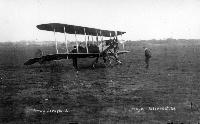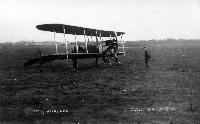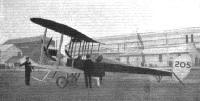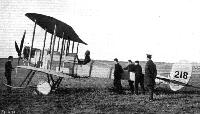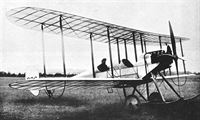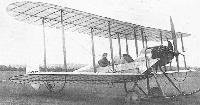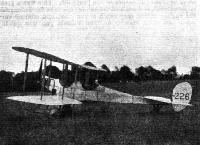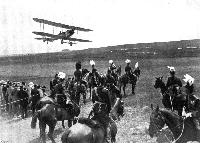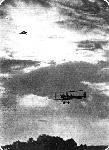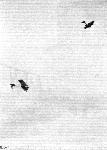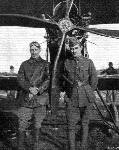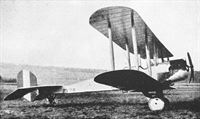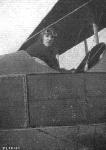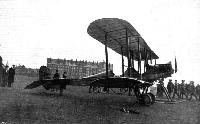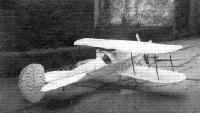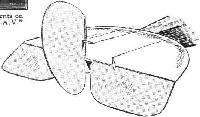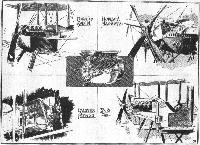В.Кондратьев Самолеты первой мировой войны
РАФ B.E.2/B.E.2a/ B.E.2b / RAF B.E.2/B.E.2a/B.E.2b
Двухместный цельнодеревянный биплан с полотняной обшивкой. Кабина летнаба размещалась спереди, пилота - сзади. Крылья без элеронов. B.E.2 - первый серийный самолет английского государственного авиапредприятия РАФ ("Ройял Эйркрафт Фэктори" - "Королевский авиационный завод"). Ранее это предприятие называлось "Его Величества фабрика воздушных шаров". В создании машины принимали участие известные в дальнейшем авиаконструкторы Дж. Де Хэвилленд и Ф.М.Грин. Постройка прототипа завершена в январе 1912 года, и 1 февраля B.E.2 совершил свой первый полет. В том же году он установил британский рекорд высоты.
В начале 1913-го в конструкцию машины внесли ряд изменений. Совершенно открытый прежде двигатель был частично закапотирован, улучшена топливная система и усилен каркас крыльев. Модификация получила обозначение B.E.2a. Вскоре ее приняли на вооружение Королевского Воздушного корпуса (RFC). Еще через год появилась очередная модификация - B.E.2b, которая отличалась оборудованием и формой кабин. Их борта сделали более высокими, а вырезы - уменьшили. Эта версия также состояла на вооружении RFC к началу первой мировой войны. Кроме завода РАФ, B.E.2 ранних модификаций строили фирмы Хэндли-Пейдж, Виккерс, Хьюлетт и Блондью.
B.E.2a стал первым английским самолетом, принявшим участие в войне. 13 августа 1914 года два дивизиона, оснащенных этими машинами, прибыли на западный фронт. Позднее к ним присоединились еще четыре. До середины 1915-го они активно привлекались для разведки и бомбардировки германских позиций. Появление в воздухе немецких истребителей сразу поставило крест на дальнейшей карьере машины. Выяснилось, что примененная на B.E.2 схема размещения экипажа делает практически бесполезной установку пулемета в кабине летнаба. Летчик же, занятый пилотированием, не мог отвлекаться на стрельбу. А скорость и маневренность B.E.2 были настолько низкими, что не позволяли ни уйти от истребителя, ни уклониться от его атак. В результате уже осенью 1915-го все уцелевшие к тому времени B.E.2 были выведены с фронта и отправлены в летные школы. Всего в частях RFC насчитывалось в разное время 32 B.E.2, 15 B.E.2a и 85 B.E.2b.
ДВИГАТЕЛЬ
Восьмицилиндровый "Рено" воздушного охлаждения, 60-70 л.с.
ВООРУЖЕНИЕ
До 50 кг мелких бомб.
Модификации
B.E.2а - двухместный учебный самолет, серийный, на базе B.E.2 1912 года с двигателем "Рено" (71 л. с.), шасси с противокапотажными лыжами. Управление осуществлялось перекашиванием крыльев (гошированием).
B.E.2b - двухместный разведчик на базе B.E.2а, отличался крыльями большего размаха и укороченными противокапотажными лыжами.
ЛЕТНО-ТЕХНИЧЕСКИЕ ХАРАКТЕРИСТИКИ
B.E.2a B.E.2b
Размах, м 10,68 11,28
Длина, м 9,00 8,61
Высота, м 3,10 3,10
Площадь крыла, кв.м 32,70 33,20
Сухой вес, кг 528 528
Взлетный вес, кг 726 736
Двигатель "Рено" "Рено"
мощность, л.с. 71 71
Скорость максимальная, км/ч 113 112
Дальность полета, км 300 300
Время набора высоты, м/мин 2135/35
Потолок, м 3220 3048
Экипаж, чел 2 2
Вооружение нет нет
Показать полностью
А.Шепс Самолеты Первой мировой войны. Страны Антанты
RAF B.E.2 1912 г.
Самолет проектировался и строился в 1911-1912 годах с участием известного английского авиаконструктора Джефри де Хевилленда.
B.E.2 - двухместный двухстоечный биплан деревянной конструкции. Фюзеляж тонкий - деревянный каркас обтянут полотном. Кабины пилота и наблюдателя (пассажира) неглубокие, и люди на треть корпуса находятся в потоке. Двигатель 8-цилиндровый, воздушного охлаждения, рядный, V-образный, установлен на металлической раме. Двигатель частично закапотирован, а цилиндры находятся в потоке. Крылья двухлонжеронные, деревянные, обтянуты полотном. Стойки бипланной коробки также деревянные. Расчалки выполнены из стальной профилированной ленты. Начиная с серии В.Е.2c крылья оборудовались элеронами. Изменены законцовки крыльев. Горизонтальное оперение нерегулируемое, обычной конструкции. Вертикальное оперение также обычное, на машинах серии "а" и "b" безкилевое, начиная с серии "c" уже устанавливался киль. На этих же машинах начали ставить горизонтальное оперение новой конструкции, прямоугольное, большего размаха. Шасси жесткой конструкции, на машинах первых двух серий - с противокапотажными лыжами. Стойки шасси деревянные. Хвостовой костыль с рыжачной амортизацией. Выхлопные коллекторы выводились первоначально под нижнее крыло, позднее - над центропланом или по бортам. Начиная с серии "c" устанавливалось вооружение - 1-2 пулемета. Управление тросовое, причем на учебных машинах - двойное.
Спроектированный как учебный самолет, с началом Первой мировой войны он использовался и строился как разведчик и легкий бомбардировщик.
Всего с 1912 по 1916 год двадцатью двумя английскими фирмами построено 3535 машин всех модификаций. С 1916 года они заменялись в строевых частях машинами Де Хевилленд D.Н.4 и D.Н.9. Но отдельные машины эксплуатировались в гражданском варианте до 1925 года.
Модификации
В.Е.2a - двухместный учебный самолет, серийный, на базе В.Е.2 1912 года с двигателем "Рено" (71 л. с.), шасси с противокапотажными лыжами. Управление осуществлялось перекашиванием крыльев (гошированием).
В.Е.2b - двухместный разведчик на базе В.Е.2a, отличался крыльями большего размаха и укороченными противокапотажными лыжами.
Показать полностью
P.Hare Royal Aircraft Factory (Putnam)
B.E.2
The B.E.2 was virtually a copy of the B.E.1, except that it was powered, from the start, by a 60hp Renault V-8 air-cooled engine. Its designation was not intended to identify it as a separate design, but merely to denote that it was the second machine built in the general-purpose tractor, or Bleriot Experimental, class. Construction of the B.E.2 was well advanced before the B.E.1 flew, the 'reconstruction' subterfuge again being used to explain its origins. Both the ill-fated S.E.1 and a damaged Breguet were named, on different occasions, as the parent aeroplane, although the latter seems more likely as it did, at least, have a Renault engine.
Among the few differences between the two B.E.s was the routeing of the newer machine's exhaust pipes down through the fuselage rather than outside it, achieving a minor reduction in drag, albeit at the expense of a consequent increase in fire risk. The B.E.2's undercarriage incorporated radius rods to locate the axle positively, particularly against longitudinal movement, and the wheel spokes were fabric covered, an innovation which not only reduced their resistance but was considered by de Havilland to 'damp out lateral oscillations'. The undercarriage skids were shorter than those of the B.E.1, lacking the long projection ahead of the propeller.
The B.E.2 made its maiden flight on 1 February 1912, with de Havilland at the controls. He appears to have judged it entirely satisfactory as built, for no modifications are recorded to have been required. This is not altogether surprising when it is remembered that all the necessary development work had effectively been carried out during the testing of the B.E.1.
De Havilland lost little time in taking up passengers, among whom were F M Green and S Hiscocks. He found its performance to be superior to that of the Wolseley-powered B.E.1 in speed and in climb.
On 21 February, after it had been fitted with a Claudel carburettor, it was flown by de Havilland to a height of 2,600ft. Two days later it made a return flight to Brooklands, covering about fifty miles.
Towards the end of March a wireless set which had been constructed at the Factory was installed in the B.E.2. Experimental transmissions were started on the 26th, but were curtailed when the equipment broke down. The result of further tests on 28 March and 1 and 2 April were described as good, and for the next week or so numerous passengers were taken up so that they could sample the novelty of airborne wireless for themselves. By 1 May a new amphibian undercarriage having both floats and wheels had been fitted, but it was found to be unsuitable for 'rolling' (taxying) and was removed. Two days later power had been increased by the fitting of a 70hp Renault, and the B.E.2's speed was measured at 68mph.
On 11 May the machine was flown to Fleet Pond, where the floats were refitted, but the trials were inconclusive because their draught proved too great for the pond and the tail float was found to be set at too small an angle. Modifications were completed by the evening, and a short flight from the water was made, but the floats were damaged on landing. It seems probable that they were not repaired, as no record has been found of any further trials with this undercarriage.
On Friday 17 May de Havilland flew the B.E.2 before the King and Queen in company with some other machines, as part of His Majesty's official review of the armed forces, and on the 31st he climbed it to 6,050ft in fifteen minutes.
By early the following month the B.E.2 had flown more than 500 miles since being fitted with the larger engine, and it continued to be used almost every day for tests of one kind or another.
During the second week of August de Havilland flew the aeroplane to Larkhill, on Salisbury Plain, where the Military Aeroplane Trials were taking place. Because Mervyn O'Gorman, in his capacity as Factory Superintendent, was one of the competition judges, the B.E.2 was clearly ineligible for the competition, but it still undertook many of the tests hors concours and achieved overall results at least equal to those of the eventual winner, the massive Cody 'Cathedral' (itself a development of the Balloon Factory's British Army Aeroplane No 1, built at Farnborough four years previously). Its use as a general 'hack', taking officials and pressmen to and fro throughout the trials, did a great deal to convince observers that aviation had reached a level of practicality which had been previously unappreciated.
On 12 August de Havilland, accompanied by Maj F H Sykes, took off at about 5.00am and, in the still, cool air of early morning, decided to test the B.E.2's climbing powers to the full. They eventually reached an altitude of 10,560ft, capturing the British record not only for flights with a passenger, but for solo flights as well.
Although the purpose of the Military Trials was to decide with which machine the RFC should be equipped, the B.E.2 was clearly more suitable than the actual winner, and the War Office decided to adopt the Factory's creation. Although a few further examples were built at Farnborough, much to the chagrin of C G Grey, orders were placed with private constructors such as the British and Colonial Aeroplane Company and Vickers. All such production machines appear to have been designated B.E.2a.
Powerplant: 60hp Renault V-8; 70hp Renault V-8
Dimensions:
span 38ft 7 1/8in (upper); 34ft 11 5/8in (lower);
chord 5ft 6in;
gap 6ft 0in;
wing area 374 sq ft;
length 28ft 4in;
height 10ft 2in;
propeller diameter 8ft 10in;
wheel track 6ft 2in;
tailplane span 11ft 0in;
tailplane area 52 sq ft;
elevator area 25 sq ft;
rudder area 12 sq ft.
Weight: 1,700lb (loaded).
Performance: (70hp)
max speed 70mph at sea level;
min speed 40mph;
climb 244ft/min to 1,000ft (60hp);
305ft/min to 1,000ft (70hp);
glide angle 1 in 6 1/4.
B.E.2a
It now seems certain that the designation B.E.2a was applied to all production B.E.2s, or to those built by contractors, rather than to any specific variant, for the earliest examples were almost identical to the prototype, certain modifications being made later without any change in designation. The 'a' suffix was not consistently applied in service use, but this did not cause any confusion at the time because virtually all the B.E.2s were 2as. Drawings bearing the title B.E.2a are dated as early as February 1912, the type is described in R & M 66, dated 12 June 1912, and the first production order was placed in August 1912, apparently before the final result of the Military Trials was known.
These early machines had unequal-span wings of NPL3a section and large lifting tailplanes exactly similar to that of the original B.E.2, the only discernible difference being the addition of a fuselage decking between the seats. Later examples, which formed the majority, had equal-span wings of a new aerofoil section which allowed a deeper rear spar and required an angle of incidence of only 3 1/2, compared with the 4 1/2 of the earlier wing, resulting in a reduction in drag without any loss of lift. Their tailplane area was reduced, the spar remaining the same to allow the original elevators to be used, and the chord being reduced to give a surface which was roughly semicircular in planform. The upper fuselage decking remained at its original length, resulting in a small flat area immediately in front of the tailplane. The new tailplane was designated T.P.2, the original surface retrospectively becoming T.P.1
Total production of the B.E.2a cannot now be quantified exactly, but appears to have been just short of 100 machines. Nevertheless, it was still the most numerous single type on the strength of the diminutive prewar RFC. Several B.E.2as served with the Royal Naval Air Service and, in addition, the type saw service in India and with the Australian Air Service. It also provided the Royal Aircraft Factory with a reliable test vehicle of reasonable performance and predictable handling with which to conduct its wide-ranging aeronautical research.
As part of E T Busk's investigations into aeroplane stability one B.E.2a, No 601, was fitted with two small fins on its upper wing, immediately over the centre-section struts. A high-aspect-ratio tailplane of rectangular planform was also fitted, braced to an inverted vee-shaped kingpost on the fuselage centreline. Known as T.P.3, it had a similar area to its semicircular predecessor, T.P.2, but was of a symmetrical aerofoil section and provided no lift in the normal flying position.
In another experiment, possibly connected with that above, No 206 (which had started its life as the B.E.6) was fitted with interplane struts which had greatly increased chord at their upper end, and were known as 'fin struts'. This aircraft was also fitted with an experimental oleo undercarriage, but appears to have reverted to its original unit.
The type also continued the wireless development tests started with the original B.E.2, aircraft 240 and 336 being among the machines chosen to carry the primitive equipment aloft.
A number of spectacular flights were made by B.E.2as piloted by regular service personnel. Number 218, a Bristol-built example, was fitted with an additional petrol tank in its faired-over front cockpit, increasing its total capacity to about fifty-four gallons. On 22 November 1913 it was flown by Capt Longcroft of No 2 Squadron from their base at Montrose directly to Portsmouth, and then, without stopping, back to Farnborough, covering a total of 560 miles in 7hr 20min. This prodigious achievement won Longcroft the 1913 Britannia Trophy for the longest flight of that year. On 13 December 1913 Capt J M Salmond, flying a B.E.2a from Upavon on Salisbury Plain, reached an altitude of 13,140ft, thereby setting a new solo British record.
A number of B.E.2as went to France with the RFC at the outbreak of the war. One of them, a No 4 Squadron machine piloted by Lt G W Mapplebeck, shared with Joubert de la Ferte's Bleriot the distinction of carrying out Britain's first active-service reconnaissance.
Despite this, and many other invaluable contributions to the conduct of the war, the B.E.2as were rapidly replaced by more recent designs and returned to England, where they gave equally useful service with training establishments.
Powerplant: 70hp Renault V-8
Dimensions:
span 36ft 11 1/8in;
chord 5ft 6in;
gap 6ft 0in;
wing area 376sqft;
stagger minus 2in;
dihedral 2°;
length; 28ft 4in;
height 10ft 2in;
tailplane area 34 sqft;
Weights: 1,100lb (empty);
1,600lb (loaded).
Performance:
max speed 74mph at sea level;
endurance 3hrs;
climb 9min to 3,000ft;
30min to 6,000ft.
B.E.2b
The B.E.2b was developed early in 1914 to afford its crew better protection from the elements, and had a modified fuselage top-decking with shallower cockpit cutouts. The rudder and elevator control runs were also revised, but in all other respects the B.E.2b was similar to the earlier model. It was built by a number of contractors. After the outbreak of war comparatively large orders were placed, several with companies not then experienced in large-scale production and, although some machines were eventually completed as B.E.2cs, the last B.E.2bs were finally delivered to the RFC in February 1917. By that time they had long been superseded by later variants which were themselves already approaching obsolescence.
Although it was usually unarmed, except perhaps for a revolver or service rifle carried by the observer, the B.E.2b was occasionally equipped to carry a few small bombs. The first Victoria Cross to be awarded to an airman was won by the pilot of B.E.2b 687, Lt W B Rhodes Moorhouse of No 2 Squadron, who, on 26 April 1915, carried out a bombing attack on the railway station at Courtrai. Although he received numerous wounds from retaliatory ground fire, he managed to bring his machine back. His injuries later proved fatal.
The B.E.2b remained in use with training squadrons, albeit in ever-diminishing numbers, right up to the Armistice. Several machines were fitted with components such as fins, sump cowlings and even undercarriages from later variants, either as 'improvements' or because the correct spares were no longer available.
Dimensions as B.E.2a.
B.E.5
The fifth of the Royal Aircraft Factory's series of two-seat general-purpose tractor biplanes returned to the B.E. 1/2 layout, but used a 60hp ENV 'F' engine recovered from the damaged Howard Wright biplane of which it was ostensibly a 'reconstruction'. Being a water-cooled engine, the ENV obviously needed a radiator, and this was mounted on the forward centre-section struts in a manner similar to that on the B.E.1.
The B.E.5's first flight was made on 27 June 1912, only three days after that of the B.E.4, and it was handed over to the RFC on 18 July. It served with No 2 (Aeroplane) Squadron for a few weeks before returning to the Factory to be re-engined with a V-8 Renault. It thus became, in effect, a standard B.E.2, and was thereafter regarded as such in service. After being returned to the RFC it served briefly with No 3 Squadron before returning to No 2, and was allotted the serial 205.
On 27 May 1913 the starboard upper wing collapsed while the aircraft was making a gliding turn at a height of about 2,500ft, and the pilot, Lt Desmond Arthur, was thrown out and killed. An investigation conducted by the Royal Aero Club's Accident Investigation Committee concluded that the cause of the disaster was a badly spliced repair near the tip of the rear spar, although there was no record of the repair being made either by the Royal Aircraft Factory or while the machine was in service. In addition to prompting the suggestion that all such repairs should be properly inspected and the name of those carrying out the work recorded, the incident triggered another attack on the Royal Aircraft Factory by C G Grey in the pages of The Aeroplane. The machine was officially struck off charge on 25 September 1915.
Data as B . E . 2.
B.E.6
Officially a 'reconstruction' of the ill-fated S.E.1, and powered by its 60hp ENV engine, the B.E.6 was identical to the B.E.5 and was built at the same time, its designation being intended not to distinguish it as a separate type, but merely to identify it as the sixth in the B.E. series of tractor machines.
The ENV engine may have sustained more damage in the crash of the S.E.1 than had been realised, for the B.E.6 did not make its first flight until 5 September 1912, some months after its sister. While it is not recorded how it was powered on that occasion, it was fitted with a 60hp Renault when it was handed over to the RFC a few days later, and it is probable that the ENV was never actually used.
The B.E.6 was given the serial 206, and seems never to have been regarded as anything other than a standard B.E.2, which, with its Renault engine, is effectively what it was. By September 1914 it had flown a total of 111 hours and, following a period with No 2 Squadron, it had been transferred first to No 4 Squadron and then to No 6, with whom it saw active service in France before being relegated to training duties back in England.
Some time during 1914 it underwent an engine change, the replacement being the 70hp Renault that was, at that time, the standard power unit for the B.E.2. Its further career and eventual fate have not been discovered.
Data as B.E.2.
Показать полностью
P.Lewis British Bomber since 1914 (Putnam)
In the Battle of Neuve Chapelle which started at 7.30 a.m. on 10th March, 1915, for the first time bombing formed a part of the plan for the conduct of such a ground operation. By attacking from the air the trains carrying reinforcements to the enemy’s army formations, it was expected that a considerable amount of delay would ensue to the Allies’ benefit. A number of raids were carried out with various aircraft against rolling stock and the railway system with excellent results.
Among the machines used was the B.E.2a. Developed from the B.E.2 two-seat biplane of 1912, the B.E.2a was adapted to carry an offensive load of a single bomb or an equivalent load of smaller bombs and was used in considerable numbers. The type appeared late in 1912 as an improved version of the B.E.2, embodying a new fuel system installed inside the curved decking which had been added to the rear of the 70 h.p. Renault engine. As a result, the gravity tank mounted previously in the centre section had been discarded. The B.E.2a’s unstaggered two-bay wings were equal in span, measured 35 ft. 0-5 in. from tip to tip and retained warping for lateral control. Structurally, no advance was visible on the standard fabric-covered, wire-braced frameworks in vogue. Those taken across to France at the commencement of the War had faithfully taken-off time and time again on their important reconnaissance work for many weeks, but, eventually, the B.E.2a found itself pressed into service as a bomber when three from No. 4 Squadron, R.F.C., set off on 11th March, 1915, to attack the rail junction at Lille. The railway station at Courtrai received attention from 2nd Lt. W. B. Rhodes-Moorhouse’s B.E.2a of No. 2 Squadron, R.F.C., on 26th April, 1915, a 100 lb. bomb falling on the line near by. The exploit resulted in the posthumous award of the Victoria Cross to Rhodes-Moorhouse, the first to be won by either the R.F.C. or the R.N.A.S.
Показать полностью
F.Mason The British Fighter since 1912 (Putnam)
RAF. B.E.2
Originally designed by Major Frederick Michael Green and Geoffrey de Havilland in 1911, the B.E.1 (Bleriot Experimental) two-seat tractor biplane demonstrated considerable evidence of advanced structural and aerodynamic thought, and its general configuration could be traced throughout its immediate successor, the B.E.2 which, in numerous sub-variants, continued to serve until the final year of the War. The prototype B.E.2 was flown by de Havilland himself at the Military Trials of 1912 and, although ineligible to compete, was shown to be superior in all respects to the Cody biplane which was declared the winner. The B.E.2, B.E.2A and B.E.2B were all unequivocally reconnaissance aircraft, being without provision for any sort of armament. Powered by the 70hp Renault, a total of 44 aircraft accompanied the RFC squadrons to France in 1914.
<...>
Показать полностью
M.Goodall, A.Tagg British Aircraft before the Great War (Schiffer)
Deleted by request of (c)Schiffer Publishing
BE.1 was nominally the 'reconstruction' of a Voisin, although probably only the engine and little else was used in the new machine. Designed by Geoffrey de Havilland, he flew it for the first time on 4 December 1911.
BE.2 was virtually an identical aircraft, but with an air-cooled engine, perhaps from the Breguet, which was the basis for its 'reconstruction'. This machine flew for the first time on 1 February 1912 and again was flown by de Havilland.
BE.1, 5 and 6 were similar machines to BE.2 and there were five more made at Farnborough in 1913, of the type loosely referred to as BE.2 type aircraft.
These machines were conventional two bay tractor biplanes, with the pilot in the rear seat of the single cockpit, although later a decking between the crew was fitted together with one behind the engine. The latter took the place of the vertical radiator, when the air-cooled engine was fitted. The exhaust pipes of the BE.2 were originally taken inside the fuselage instead of underneath. Differences in the length of the undercarriage skids, and the substitution of equal span wings, were other variations introduced over the period of the aircraft's life. Changes to the rigging of the wings were made during testing, but these were originally unstaggered and without dihedral and with warping control.
The BE.2 was fitted with twin main and tail floats as an amphibian and as a pure seaplane, in which latter form it apparently lifted off when tested on the Fleet Pond.
Power:
60hp Renault eight-cylinder air-cooled vee BE.1 and 2 60hp ENV type F eight-cylinder water-cooled vee BE.5 and 6
70hp Renault eight-cylinder air-cooled vee BE.2, 6 and others
Data for BE.2 with 70hp Renault
Speed range 40-70mph
Climb 305ft per min. to 1,000ft
BE.2a and BE.2b biplanes
The BE.2a was evolved from the previous variants of the BE.2 in the middle of 1912, into a machine suitable for use by the Military Wing, and orders were placed with a number of firms. Approaching one hundred BE.2a aircraft were built.
The type inherited the unequal span wing initially, although the majority were fitted with wings of equal span and a new section, rigged with reduced incidence. The aircraft incorporated the front and rear deckings added to previous machines. A semicircular tail plane was standardized which had reduced area.
Individual machines were used at Farnborough to test various new installations in connection with research into stability, such as triangular fins above the center section, increased width at the top of the interplane struts, and alternative tailplanes.
A BE.2a No.218, converted to a single-seater, with an extra fuel tank in the front cockpit, flew 560 miles nonstop in 7hr 20min on 22 November 1913, flown by Capt. Longcroft. On the 13 December 1913, Capt. Salmond established a British height record, by reaching an altitude of 13,140 feet.
The BE.2b gave the crew better protection, by changes to the top decking and embodied revised control runs, but was basically the same aircraft as the BE.2a. The BE.2b was developed in early 1914 and was ordered in considerable numbers from contractors, the last deliveries being made to the RFC, the prime user, in February 1917. The development of the basic BE.2 series was continued in 1915 and later.
The earliest manufacturers of the BE.2a were Vickers, Sir W.G. Armstrong-Whitworth, British & Colonial (Bristol), Coventry Ordnance Works (COW), S.E. Saunders, Handley Page and Hewlett & Blondeau. Some of these firms continued to make the BE.2b and later versions.
Power: 70hp Renault eight-cylinder air-cooled vee driving a 8ft 10in diameter four-bladed propeller
Data
Span 36ft 11 in (Early aircraft, top 37ft 7in, bottom 34ft 10 l/2in)
Chord 5ft 6in
Gap 6ft
Area 376 sq. ft (Early aircraft 357 sq. ft)
Area elevators 25 sq. ft
Area rudder 12 sq. ft
Area tailplane 34 sq. ft
Length 28ft 4in (29ft 6 l/2in; long skids)
Height 10ft 2in
Weight 1,2741b.
Weight allup 1,600lb.
Max speed 70 mph
Climb to 3,000ft 9 min
Endurance 3hr
Показать полностью
P.Lewis British Aircraft 1809-1914 (Putnam)
B.E.2, B.E.2a and B.E.2b
The success of the B.E.1 was instrumental in the decision of the Army Aircraft Factory to proceed with further development of the B.E. category. The result was an improved version of the original machine, and was designated B.E.2. Edward Tcshmaker Busk played a great part in the test-flying and subsequent development of the machine at Farnborough upon its completion early in 1912, concentrating his efforts towards making as stable an aircraft as possible.
The prototype B.E.2 received wings of unequal span, a 60 h.p. Renault engine, and was without decking between the tandem cockpits. Subsequent examples differed in detail, but generally were fitted with equal-span 35 ft. 0 1/2 in. wings, a 70 h.p. Renault, and had better passenger protection conferred by inter-cockpit coamings. B.E.2 No. 205 flew experimentally with a 60 h.p. E.N.V. "F" engine.
On 12th August, 1912, Lt. Geoffrey de Havilland took Major F. H. Sykes, Commandant of the Military Wing of the R.F.C., to a record height of 10,560 ft. in 45 mins., carrying a useful load of 450 lb. At the 1912 Military Trials on Salisbury Plain, de Havilland flew the B.E.2 in the various tests to obtain comparative performance figures. The machine could not compete officially for a War Office order as it had been built at the Army Aircraft Factory, but its performance at the Trials established its undoubted superiority compared with its contemporaries. The B.E.2 climbed to 10,000 ft. at 365 ft. min., came fifth in the gliding test with a gliding angle of 1 in 6.25, was sixth in maximum speed at 70 m.p.h. and flew at a minimum of 40 m.p.h. On 13th February, 1913, No. 2 Squadron, R.F.C., started on its move by air from Farnborough to Montrose, Scotland. Two B.E.2s were piloted by Capts. C. A. H. Longcroft and J. H. W. Becke, flying North in company with three Maurice Farmans. Several landings had to be made en route owing to bad weather and engine trouble, the unit finally arriving at the new base on the 26th of the month.
Late in 1912 another modification of the basic B.E.2 design appeared in the form of the B.E.2a. Alterations included wings of equal span, together with the addition of decking behind the 70 h.p. Renault and the installation of a revised fuel system. Among other changes were undercarriage skids ending in hooks at the front, and a version was tested with oleo legs. Flying characteristics with a fixed fin at the tail were investigated, while No. 601 flew with a pair of triangular fins above the centre section of the upper wings, a modified tailplane fitted with a centre bracing post, and a large windscreen for the pilot's rear cockpit. Several subcontractors were called upon during 1912 to supply the B.E.2a to both Military and Naval Wings of the R.F.C.
During 1913 a number of outstanding flights were made with the type. On 19th August, Capt. C. A. H. Longcroft of No. 2 Squadron, R.F.C., flew Col. F. H. Sykes from Farnborough to Montrose in one day. The distance of 287 miles to Alnmouth, at which the only stop was made, constituted a new British non-stop point-to-point record with passenger. On 22nd November, Capt. Longcroft flew 445 miles non-stop from Montrose to Portsmouth in B.E.2a No. 218, and then on to Farnborough to make a total distance covered of 650 miles in 7 hrs. 20 mins. Tanks carrying enough fuel for 8 hrs. flying were fitted, and the Jast performance won for the pilot the Britannia Trophy presented by Horatio Barber for the best flight of the year. On 13th December, Capt. J. M. Salmond flew a B.E.2a from Upavon to a new British solo altitude record of 13,140 ft. Another distinction fell to the B.E.2a at 8.20 a.m. on 13th August, 1914, when No. 347 of No. 2 Squadron, R.F.C., piloted by Lt. H. D. Harvey-Kelly, landed at Amiens, thereby becoming the first British aircraft to land on the Continent during the 1914-18 War.
A further modification of the B.E.2a, designated B.E.2b, was produced during early 1914. This incorporated a redesigned fuselage with greater crew comfort bestowed by deeper cockpit coamings. Rudder and elevators of revised shape were fitted also, and in some cases a plain vee-type under-carriage replaced the skid type. In its final form the B.E.2b was equipped with ailerons instead of the warping control fitted to all previous models of the B.E. series.
Prior to the outbreak of war, the B.E.2 was supplied to Nos. 2, 4, 6 and 7 Squadrons, R.F.C., and to the Eastchurch Squadron of the R.N.A.S.; the B.E.2a to Nos. 2, 3, 4 and 6 Squadrons, R.F.C., and to the Eastchurch Squadron of the R.N.A.S.; and the B.E.2b to Nos. 4 and 6 Squadrons, R.F.C. The type was used also for training at the C.F.S.
SPECIFICATION (B.E.2)
Description: Two-seat tractor biplane. Wooden structure, fabric covered.
Manufacturers: Army Aircraft Factory, Farnborough, Hants. Sub-contracted by Handley Page Ltd., Cricklewood, N.W.2; Hewlett & Blondeau Ltd., Omnia Works, Clapham Junction, S.W.; Vickers Ltd., Knightsbridge, S.W.I.
Power Plant: 70 h.p. Renault, 60 h.p. E.N.V. "F".
Dimensions: Span, 38 ft. 7.5 ins. (later 35 ft. 0.5 in.). Length, 29 ft. 6 5 ins. Wing area, 374 sq. ft. (later 352 sq. ft.).
Weights: Empty, 1,274 lb. Loaded, 1,600 lb.
Performance: Maximum speed, 70 m.p.h. Climb, 360 ft./min. Service ceiling, 10,000 ft. Endurance, 3 hrs.
Показать полностью
J.Bruce British Aeroplanes 1914-1918 (Putnam)
B.E.2, 2a and 2b
THE first B.E.2 appeared early in 1912. There was little to distinguish it from the B.E.1, for the differences lay in details only. Indeed, it is possible that the designation signified that the particular aircraft was the second aeroplane in the B.E. category rather than that it was a distinct and separate type from the B.E.1. Similar considerations probably applied in the cases of the aeroplanes which became known as the B.E.3, 4, 5, 6 and 7, and what may have been merely sequence numbers came to be used as type numbers. However that may be, the design of B.E. No. 2 became standardised as the B.E.2, and the type was produced in small numbers.
The B.E.2 was powered by the more powerful 70 h.p. Renault engine, but the basic airframe was similar to that of the B.E.1. The fuselage was unchanged, but the top-decking behind the cockpit was shortened by one bay and the fairleads for the rudder cables were brought forward a corresponding distance.
The tailplane and elevators of the B.E.2 were of greater area, and the mainplanes were rigged with a small dihedral angle; the upper wing was of slightly greater span than the lower. The undercarriage was again of the twin-skid type, but the skids were shorter and radius rods were fitted to prevent longitudinal movement of the axle.
Some of the earliest B.E.2s were produced by “rebuilding” other crashed aeroplanes, and at first there was no real standardisation. The 70 h.p. Renault was the engine normally fitted, but B.E.2 No. 205 had a 60 h.p. E.N.V. at one time. The later B.E.2s had wings of equal span, and separate cockpits were provided for the crew by the addition of a short length of decking between the seats. A gravity fuel tank was mounted under the centre-section. The observer, who occupied the front seat, was almost completely exposed, for there was no cowling or decking behind the engine.
The usual wooden construction was used throughout, apart from the outlines of the elevators and the complete rudder, which were made of steel tubing.
In May, 1912, King George V visited Farnborough and inspected the Military Wing of the R.F.C.: on this occasion B.E. machines were flown before the King. On August 12th of that year, Geoffrey de Havilland broke the British altitude record by flying a B.E.2 to 10,560 feet with Major F. H. Sykes as passenger. The B.E. reached that height in about 45 minutes.
This flight alone was convincing evidence of the machine’s quality, but a few days later it was put through some of the official tests which constituted the 1912 Military Trials. The Trials were intended to select the aeroplane best suited to the requirements of the R.F.C., and were on competitive lines. They were flown off at Salisbury Plain.
The B.E.2 was flown hors contours by Geoffrey de Havilland: having been built at the Royal Aircraft Factory it was not eligible to compete in the Trials. Its performance in these trials showed that it was the best all-round machine there; better in all important respects than the Cody biplane which was declared the winner of the competition, but which owed its success to its 120 h.p. Austro-Daimler engine and not to any excellence of design.
The B.E.2 was built in some numbers for the equipment of the R.F.C. Only a handful were made at the Royal Aircraft Factory itself, and the majority were made by Handley Page, Ltd., Hewlett and Blondeau, Ltd., and Vickers, Ltd.
Late in 1912 the B.E.2a appeared. This variant had a revised fuel system, and decking was fitted behind the engine: it enclosed the tank which was installed there and gave the observer some protection from the elements and the regurgitations of the Renault. There was no gravity tank under the centresection. Stronger interplane struts were fitted, but otherwise the airframe was unchanged.
The early B.Es gave excellent service with the R.F.C. and R.N.A.S., but official records seldom distinguish the B.E.2a from the B.E.2. When No. 2 Squadron was sent from Farnborough to Montrose, where it was to work as an independent unit, two of its B.Es were flown all the way by Captain J. H. W. Becke and Lieutenant C. A. Longcroft. The flight began on February 17th, 1913, and ended on February 26th. In August, 1913, Captain Longcroft flew from Farnborough to Montrose in one day with Lieutenant-Colonel Sykes as his passenger. For this flight his B.E.2a was fitted with an auxiliary fuel tank under the passenger’s seat.
Three months later, on November 22nd, 1913, Longcroft flew B.E.2a No. 218 from Montrose to Portsmouth and back to Farnborough non-stop. The flight was accomplished in 7 hours 20 minutes, and the total distance covered was about 650 miles. The B.E. was flown solo, for the faired-over front cockpit contained a special fuel tank designed and installed by First Class Air Mechanic H. C. S. Bullock: this tank held fuel for eight hours’ flying.
Many experiments were carried out on B.E.2s and 2a’s. Much pioneering work with oleo undercarriages was done on the type, notably with B.E.2 No. 206. In September, 1912, still with its oleo undercarriage, it was handed over to No. 2 Squadron. Five months later it was transferred to No. 4 Squadron, after which it was fitted with the standard twin-skid undercarriage. Throughout 1913 and 1914, No. 206 was flown extensively, and on December 18th, 1914, it was sent to France to join No. 6 Squadron. In the summer of 1915 it was fitted with a vee undercarriage of the B.E.2C type and survived until September of that year, when it was written off in a crash.
The oleo undercarriages which were fitted to various B.E.2s and 2a’s varied in appearance. Some were simple variants of the twin-skid layout, but one machine had an undercarriage similar to that of the F.E.2b and R.E.7; this B.E. also had a modified tail unit.
Experiments in stability were conducted with B.E.2a’s. At one time No. 601 had two fin surfaces above the centre-section and a high aspect-ratio tailplane which was braced from a central kingpost. The pilot’s cockpit was later fitted with an unusually large windscreen.
The wireless experiments which had been started in 1912 on the B.E.1 continued with B.E.2s. In 1913, just before the Army manoeuvres, Lieutenant B.T. James succeeded in receiving wireless signals with the engine of his B.E. running at full throttle. In June, 1914, he and Lieutenant D. S. Lewis flew from Netheravon to Bournemouth in two B.Es: each machine carried transmitting and receiving apparatus. The B.Es flew about ten miles apart and kept in communication with each other throughout the flight.
Work of this kind naturally stood the R.F.C. in good stead when war broke out. Four squadrons took the field, of which two (Nos. 2 and 4) were equipped throughout with B.Es. The first British aeroplane to land on the Continent after the outbreak of war was a B.E.2a of No. 2 Squadron. Flown by Lieutenant H. D. Harvey-Kelly, B.E.2a No. 347 left Dover at 6.25 a.m. on August 13th, 1914, and landed near Amiens at 8.20 a.m.
A few other B.Es were taken to France by the Aircraft Park, and three were among the equipment of Wing Commander C. R. Samson’s squadron of the R.N.A.S. which went to France on August 27th, 1914. One of the three was Samson’s own B.E.2a, No. 50, which gave long and faithful service from the time of its delivery in January, 1914, until January, 1916. During those two years, No. 50 had waged war in France and at the Dardanelles with that offensive spirit which typified Samson. This B.E. found an honoured resting place on Imbros, whence it had flown so often on its warlike occasions; for when No. 3 Wing of the R.N.A.S. returned to England, old No. 50 was condemned as unfit to travel and was broken up.
In France, the B.Es were used for reconnaissance duties; indeed one of the first reconnaissance flights after the arrival of the R.F.C. in France was made by Lieutenant G. W. Mappiebeck of No. 4 Squadron, flying a B.E.2a. As the war progressed bombs were carried. On March i ith, 1915, three B.E.2S of No. 4 Squadron set out to attack a railway junction at Lille, but none returned to the squadron’s aerodrome: engine failure brought all three down.
The first Victoria Cross to be won by a member of the British flying services was posthumously awarded to Second Lieutenant W. B. Rhodes-Moorhouse of No. 2 Squadron for his bombing attack on Courtrai railway station on April 26th, 1915. He brought his B.E.2 down to 300 feet to drop his 100-lb bomb on the line west of the station, but was mortally wounded by ground fire. Although in great pain, he flew his B.E. back to his own aerodrome at Merville in order to make his report: there were other, nearer aerodromes where he could have landed, and he was wounded twice more on his return flight. Next day, before he could know of the recognition of his superb gallantry, he died of his wounds.
The B.E.2a was used in small numbers in other parts of the world. Two, of which No. 50 was one, went to the Dardanelles with No. 3 Wing of the R.N.A.S.: the other machine was composed of components of three different B.Es, but Wing Commander Samson described it as “a real good machine.”
B.E.2a’s had been sent to Australia and India in 1914, and one of the machines from the Indian Flying School at Sitapur was sent to Egypt in December, 1914, as part of the equipment provided for the reinforcement of the Ismailia Flight of the R.F.C. In company with two Maurice Farmans this B.E.2a bombed El Murra on April 16th, 1915.
During 1914, the basic design was further improved and a version of the B.E.2 appeared with a new fuselage. This variant was designated B.E.2b and was distinguishable by its improved top-decking, which was fuller and gave better protection to the crew. Revised rudder and elevator controls were also installed, and late B.E.2b’s had ailerons for lateral control. Some had plain vee undercarriages: one machine which was thus equipped was No. 2778, which also had a cowling on the sump of its engine.
As fighting in the air developed throughout 1915, the early B.E.2s became progressively more ineffective as military aircraft. The type was never designed to carry a machine-gun, and was easily outclassed in combat. By September 25th, 1915, the R.F.C. in France had only two B.E.2a’s and four B.E.2b’s on its strength, and the type was completely withdrawn soon afterwards.
After being retired from operational service, the B.Es were quite widely used at training aerodromes.
SPECIFICATION
Manufacturers: The Royal Aircraft Factory, Farnborough, Hants.
Other Contractors: Sir W. G. Armstrong, Whitworth & Co., Ltd., Gosforth, Newcastle-on-Tyne; The British and Colonial Aeroplane Co., Ltd., Filton, Bristol; the Coventry Ordnance Works, Ltd., Coventry; Handley Page, Ltd., no Cricklewood Lane, London, N.W.; Hewlett & Blondeau, Ltd., Clapham, London; Vickers, Ltd. (Aviation Department), Imperial Court, Basil Street, Knightsbridge, London, S.W.; Whitehead Aircraft Ltd., Richmond, Surrey.
Power: 70 h.p. Renault. One B.E.2 had the 60 h.p. E.N.V. engine.
Dimensions: Span: upper 38 ft 7 1/2 in., later 35 ft 0 1/2 in.; lower 35 ft 0 1/2 in. Length: 29 ft 6 1/2 in. Incidence: 3. Span of tail: 12 ft. Wheel track: 6 ft 2 in. Airscrew diameter: 8 ft 10 in.
Areas: Wings: upper 202 sq ft, later 180 sq ft; lower 172 sq ft; total 374 sq ft, later 352 sq ft. Tailplane: 52 sq ft. Elevators: 25 sq ft. Rudder: 12 sq ft.
Weights: Empty: B.E.2a, 1,274 lb. Loaded: B.E.2, 1,650 lb; B.E.2a, 1,600 lb.
Performance: B.E.2a: Maximum speed at ground level: 70 m.p.h.; at 6,500 ft: 65 m.p.h. Climb to 3,000 ft: 9 min; to 7,000 ft: 35 min. Service ceiling: 10,000 ft. Endurance: 3 hours.
Armament: One 100-lb bomb or equivalent weight of smaller bombs; hand grenades were also carried. Rifles, pistols and carbines were carried as defensive weapons.
Service Use: Western Front: R.F.C. Squadrons Nos. 2, 4, 6, 8, 9, 12, and 16; R.N.A.S. Squadron at Dunkerque. Aegean: No. 3 Wing, R.N.A.S., Tenedos and Mudros. India: Indian Flying School, Sitapur. Egypt: Ismailia Flight, R.F.C. Australia: Flying School at Point Cook. Training: various training units, including Central Flying School, Upavon, and training squadrons at Gosport, Stirling, Wye and Wyton.
Production and Allocation: The total production is not known. The British and Colonial Aeroplane Co. built nineteen
B.E.2a’s and six B.E.2b’s. The R.N.A.S. had five B.E.2s and 132 were delivered to the R.F.C., as follows: 2a’s at the outbreak of war, and a total of 132 were delivered to the R.F.C., as follows:
B.E.2 B.E.2a B.E.2b
Expeditionary Force, 1914 30 6 8
Expeditionary Force, 1915 - 1 10
Expeditionary Force, 1916 - - 1
Middle East Brigade, 1916 - 1 1
Home Defence, 1917 - - 1
Training Units, 1914 2 1 5
Training Units, 1915 - 5 -
Training Units, 1916 - 1 33
Training Units, 1917 - - 26
Totals 32 15 85
Serial Numbers: B.E.1: 201. B.E.2, 2a, 2b: 46, 47, 49, 50, 202, 205, 206, 217, 218, 220, 222, 225-242, 249, 267, 272, 273, 298, 299, 303, 317, 318, 327-336, 340, 347-349, 368, 372, 396, 397, 441, 442, 447, 449, 452-454. 457, 465, 466, 470-487, 547, 601, 667, 709, 2778, 2884.
Notes on Individual Machines: 46 and 47: built at R.A.F. for Admiralty. 49 and 50: built by Hewlett & Blondeau for Admiralty. 205: rebuilt from Howard Wright biplane; at one time had 60 h.p. E.N.V. engine; crashed May 27th, 1913. 218: B.E.2a flown by Captain Longcroft. 226: B.E.2a built by British and Colonial Aeroplane Co.; subjected to exposure test, tested to destruction April 23rd, 1914; used by No. 3 Squadron. 240: experimental wireless installation. 348: B.E.2a fitted with R.A.F. Recording Tautness Meter. 396, 397 and 487 were B.E.2b’s built by the British and Colonial Aeroplane Co. under Contract No. A.2366. 601: used in stability experiments. 709, 2778 and 2884 are known to have been B.E.2b’s.
Показать полностью
H.King Armament of British Aircraft (Putnam)
B.E.2, 2a and 2b. The most famous armed exploit by an early aircraft of the B.E. series, which originated in 1912, was the dropping of a 100-lb bomb by 2nd-Lieut W. B. Rhodes-Moorhouse from a B.E.2a on Courtrai railway station on 26 April, 1915. Smaller bombs were carried, including two 20-lb, and one B.E.2a, flying without observer, was armed with one petrol bomb and 'as many grenades as the pilot could manage'. Late in 1914 the Royal Aircraft Factory produced a bomb-carrier for the B.E.2a. This held three bombs and was suspended well below the fuselage forward of the undercarriage axle. Other types of carrier were attached between the rear struts of the undercarriage. Pistols, rifles and carbines were carried, and No.50 is known to have had a rifle clamped to the side of the fuselage. One B.E.2a was used to test the Fiery Grapnel weapon, developed at the Royal Aircraft Factory for entanglement with, and explosion upon, airships. Grenades were carried on anti-airship patrols.
J. M. Bruce has recorded that at about mid-1912 it was reported that experiments were being conducted at Farnborough with a type of Vickers gun on a B.E. aircraft piloted by Geoffrey de Havilland. The gun was rumoured to weigh only 15 lb complete and to fire at the rate of 400 rounds per minute. Flight reported early in November 1912 that a biplane of B.E. type was being used at Aldershot for experiments with a Maxim gun, but whether this was a confusion with the F.E.2 (which, as a photograph shows, was definitely tilted with a Maxim gun) cannot be determined. The most diligent research gives no hint of a Vickers gun weighing 15 lb, and even the 'stripped' Lewis gun weighed 17 lb. The only aircraft machinegun known to the author which approached the reported weight was the French Darne, an experimental model of which was chambered for the British 0.303-in cartridge and which weighed 15 1/2 lb, but this gun did not exist in 1912.
Показать полностью
O.Thetford British Naval Aircraft since 1912 (Putnam)
B.E.2A
The B.E.2a served with both the Military and Naval Wings of the RFC from 1912. Naval Wing was allotted Nos.46, 47, 49 and 50, the last of these becoming the favourite mount of the famed Cdr Samson. It accompanied the Eastchurch Squadron to Belgium in August 1914 and served again with Samson in the Dardanelles region. One 70 hp Renault engine and a loaded weight of 1,600 lb. Maximum speed, 70 mph at sea level. Climb, 5 min to 7,000 ft. Endurance, 3 hr. Service ceiling, 10,000 ft. Span, 38 ft 7 1/2 in. Length, 29 ft 6 1/2 in.
Показать полностью
O.Tapper Armstrong Whitworth Aircraft since 1913 (Putnam)
The B.E.2a, B.E.2b and B.E.2c
The first aeroplanes to be built by Armstrong Whitworth for the Government were eight B.E.2as which had been ordered in 1913. The B.E. series originated at the Army Aircraft Factory at Farnborough (renamed the Royal Aircraft Factory in 1912) and the first aircraft of the type, the B.E.1 which appeared in 1911, was the result of collaboration between two of the Farnborough designers, F. M. Green and Geoffrey de Havilland. The B.E.1 was very advanced for its time, both structurally and aerodynamically, and it did much to establish the fashion for the tractor biplane which was to persist for so many years.
The B.E.2a, powered by a 70 hp air-cooled Renault engine, appeared towards the end of 1912 and was basically similar to the preceding B.E.1 and B.E.2 aircraft. The structure was of wood, fabric covered, with unstaggered two-bay biplane wings. The tailplane was semicircular with divided elevators, and the rudder had no fixed fin; lateral control was by wing warping. The undercarriage had two long skids to protect the propeller.
While the first eight B.E.2as were still under construction in 1913, Armstrong Whitworth received a further order from the War Office, this time for twenty-five B.E.2b aircraft. The B.E.2b was a further refinement of the type with a redesigned fuselage and other improvements, including, in later versions, the substitution of ailerons for wing warping.
<...>
B.E.2a
Span: 35 ft 0 in (10.67m)
Length: 29 ft 7 in (9.02 m)
Wing area: 352 sq ft (32.70 sq m)
All-up weight: 1.600 lb (726 kg)
Показать полностью
Журнал Flight
Flight, August 17, 1912.
THE MILITARY COMPETITIONS.
By Our Technical Editor.
SOME NOTES ON, AND A RECORD BY THE ROYAL AIRCRAFT FACTORY'S BIPLANE "BE 2" AT SALISBURY.
A GROUP of people ran madly across a ploughed field and I beat Coanda, designer of the Bristols, by a short head and a twisted foot at the last hole. The excitement is due to the sight of an approaching aeroplane, Prevost on the French "Dep." being expected to lead off in the landing test of the Military Competition on Salisbury Plain. The sheds are three or four miles away, and the plough is an isolated spot with its little band of enthusiastic spectators, who collect together in a great grass hollow in the centre of the field, which, surrounded by warning flags, constitutes a safe vantage point in the very heart of the danger zone. Someone with binoculars, or perhaps Strickland with his telescope - which is a much more useful instrument for this sort of work, having so well combined the three qualities of magnification, field and light - finds out that it is not the "Dep." that is skimming towards us out of the lower sky, but a non-competitor, to wit, de Havilland, on the Royal Aircraft Factory's tractor biplane BE 2.
On board is Major Sykes - secretary to the meeting, an indefatigable worker, and a friend to journalists and other importunate people generally - who has come over to inspect the ground. Like a bird, the machine alights gracefully in an adjacent field, those aboard take a glance in our direction; and like a bird again, the aeroplane hops over the fence and alights with equal ease and safety on the plough, just as if it were running light instead of carrying the regulation 350 lbs. of load in addition to fuel and oil for 4 1/2 hours. Then it taxies round to get into position and rises out of the harrow up wind and once more goes over the fence into the next field so as to be out of the way while Prevost, on the French Dep., who has now approached, slips into the furrow in a cloud of dust and comes gently and safely to rest. A moment's halt and he is off again up wind, with a wire fence less than 150 yards in front of him; it is a close thing, for a ploughed field is slow going on wheels, but with a final sprint the aeroplane springs lightly up into the air and is off through distant space.
And there stands BE 2 quietly on the grass in the next field, inviting a ride. "Will you take me back to the sheds, de Havilland, while Major Sykes is busy talking to Gen. Henderson?" I ask, and "Yes, certainly, but you may find it bumpy," says G. de H., putting on his flying cap and goggles, while I clamber into the front seat, a wicker basket affair that seems uncommonly comfortable. Going to the propeller de Havilland gives it a pull round, as one would start a motor-car engine, and the 70-h.p. Renault gets gently into action. No one holds the machine as the pilot calmly walks round to the back and gets into his seat, for the engine is throttled down to a speed at which the propeller draught exerts but an insignificant thrust compared with that which is presently to come.
Opening the throttle a little we turn round into position, for at first the machine was within a few feet of the fence, and accelerate down wind. Not a bump of any description comes to indicate whether or no we are still in contact with the earth, but it is quite certain a moment later that we are flying as with a quiet but determined stride the machine steps up into the air. And then the ascent continues and the ground that used to be in front of one's eyes lays itself down like a carpet to be looked upon and walked over with fairy-like footsteps from above.
It is already difficult, these days of things that are facts, and children coming to a knowledgable age who have never known the air without its engine-driven birds, to remember the romance of flying and a little of its mystery. Up aloft there on the magic carpet I tried to think of it so, and something of the mental atmosphere appropriate to the thought clouded the mind for awhile, so that the whirr of the engine and the draught from the screw wove themselves into a dreamland, where I walked upon air, and felt like a god in the realm of space looking at the world and her little men tied to the earth below. And the novelty of the situation - for to dream that one is flying is not uncommon - is to find that the dream is true; true, that is to say, so far as the reality of being up in the air is concerned; but as to the feeling of omnipotence appropriate to the rest of the analogy - well, that depends a little on the temperature of the toes. "Cold feet" would be a poor thing to suffer from on BE 2, with de Havilland at the mushroom-topped control-lever; and my shoes were on the exhaust-pipe, anyway, as I only discovered when the leather had ceased to be useful any more as a non-conductor of heat.
As for the going of the machine, we were running with the wind at anything between 75 and 80 miles an hour and it seemed as steady as a rock. Once there was a little drop such as a small boat might give in a "lop" and once a little heave as we passed through a choppy sea. And now the sheds are just in front, so de Havilland puts round into the wind on a small bank and we glide downwards with a smooth easy motion that appeals to me as the most exhilarating part of a flight and one least associated in my mind with any feeling of nervousness, notwithstanding that the ground approaches with an amazing rapidity. At the last moment, a skilful movement of the elevator flattens out the machine so that it flies parallel to the ground and a second later the wheels touch the grass and we come to rest on terra firma once more.
Of all the events in the trials, none have impressed me more than this simple flying to and fro. Neither the intricate manoeuvring of the Deperdussin by Prevost, the "flat gliding" by Verrier on the Maurice Farman, the rocket-like ascent of Bielovucic on the Hanriot, the wind riding by Bell on the Martin Handasyde, nor the several performances of other excellent machines have quite served to bring home the utility of the aeroplane as did the simple assurance with which de Havilland used BE 2 in the service of those who had occasion to go from place to place.
One of the neatest biplanes ever built, and one moreover that impresses the engineering sense with an immediate satisfaction in the quality of its design, BE 2 demonstrates the value of scientifically practical research at its every flight. It is never flown save with a purpose, and few flights fail to bring some factor of utility to the store of knowledge possessed by the R.A.F.
Its main planes are of practically equal span, the upper being slightly the longer. Their area is 372 sq. ft., the weight of the machine is 1,050 lbs., and it flies at about 1,600 lbs. under the conditions of the Military Trials. The struts, two pairs on each wing, are flexibly mounted and cross-braced with steel wire. The rear bracing consists of the warping wires, which pass over pulleys set on a level with the planes. The body, which also forms a backbone to carry the tail, accommodates pilot and passenger in tandem, the latter being in front and having an excellent view in all directions, for the engine, a 70-h.p. V-type Renault is well forward and does not obstruct the view at all. The engine is carried on tubular steel extensions of the upper boom of the backbone, which also serve excellently as points from which drift wires can be taken to the upper and lower planes and to the chassis.
It is the best stayed machine in this respect that I have seen. Guy wires are also carried from the extremities of the middle front struts to the backbone, joining it at a point about two-thirds of the way to the tail, and from the top of the front struts that stand out of the body to a point on either side of the pilot's seat. Beneath, from these points, wires go to the chassis skids, from which spring wires to the inner sides of the lower planes. Thus there are two lift wires from beneath the centre of each front spar to the ends of the skids, and two fore and aft diagonals to stiffen the backbone against side shocks from above the same point.
It is a most scientifically-stayed machine, for a very complete system of trussing has been effected with few wires, and certainly the apparent head resistance is small.
By these wires, body, undercarriage and wings are formed into a composite unit that ought to have an immense rigidity notwithstanding the slender grace that is such a characteristic of the machine's appearance. Not always is it evident that aeroplane designers pay sufficient regard to the fact that the backbone makes a very powerful lever wherewith to strain itself out of alignment with the planes in times of great stress and shock. Or, the importance of the stay wires enumerated above, may be regarded from the point of view of the necessity for steadying the wings in both directions in their own plane. Drift wires are none too common, and wires that oppose the drift wires are still less often to be seen. The combination of the two is a simple and excellent method of giving lateral rigidity to the backbone and of ensuring the maintenance of the proper alignment of the wings with this member.
The tail has a large semi-circular fixed plane with a slight top camber. This is fastened to the top of the backbone, which from this point has a turtle deck as far as the pilot's seat, in order to give a fair streamline run. The elevating-flaps are together almost as large as the tail, while the rudder is a little smaller than one of the elevator-members, and seems well proportioned to the size of the machine. A simple pivoted skid, with spring attachment, supports the tail on the ground.
The undercarriage consists of six struts and two skids, arranged on a modified plan of the A-frame principle. The skids project well forwards, but are not much curved. The axle lies across them near the rear, and two struts spring upwards and apart from each heel to carry the body. A third strut rises from near the toe to stay the engine-bearers.
It is difficult to explain in words the precise quality in the design of this machine that calls forth the admiration of the engineer, and it is certainly not in any way due to smart finish of superficial details, for although the workmanship is excellent, the hand of the experimenter is on it still. The fact remains, that for a well-designed tractor- biplane, BE 2 of the R.A.F. is hard to beat, and some points in it might well be worth copying by those in search of Army orders.
On Monday, August 12th, at about 5 o'clock in the morning, de Havilland made a splendid altitude ascent on BE 2 which must be very nearly, if not actually, a record. The barograph registered 9,500 feet when he came down three hours later and the starting point to which the zero of the instrument was set is already about 400 feet or more above sea level. Roughly speaking, therefore, BE 2 in ordinary touring trim with pilot and passenger (Major Sykes), all its fuel, oil, instruments and other odd "gadgets" went up to the region of 10,000 feet above sea level. It was flying, in fact, under trial conditions and with no special preparation other than is proper to the keeping of an aeroplane, or any other machine, in going order. Weighed immediately after the descent the machine alone scaled 1,274 lbs., of which 30 lbs. rested on the weighbridge under the tail skid. To this must be added the fuel and oil used on the three hours' trip, the pilot and passenger, who scaled 315 lbs. together. At starting, the weight in flight was therefore probably in the order of 1,750 lbs.
The first 1,000 ft. was timed by Major Sykes at 2 mins. 55 secs., i.e., at 344 ft. per minute. This represents an expenditure of about 18-h.p or 25.5 per cent, of its rated power, which is very high, is an indication of general efficiency, and some evidence of a very useful narrow 4-bladed screw. The 7,000 ft. level was reached in 35 mins., but from 6,000 ft., upwards, the rate of climbing was very slow, owing to the rarefied atmosphere at these altitudes. The barometer hereabouts reads only in the neighbourhood of 20 ins. of mercury, so that there is a very great decrease in the mass of air deflected by the planes at a given speed. In the end, the lift diminishes so much that there is no surplus for further ascent and the machine stops climbing. This happened at 9,500 ft. with BE 2, because de Havilland tried for half-an-hour to get higher, but was unable to do so.
In climbing at great altitudes, pilots always keep a steady angle of inclination and de Havilland sets BE 2 until her flight speed is down to 47 m.p.h. If there is no change in the barograph after a reasonable time under these conditions, the ascent is finished, it is impossible to go higher and it is generally time to come down. The descent is at first more rapid than normal in the region of reduced pressure. No trouble with the carburettor was experienced from start to finish and no adjustment was made; nor did either pilot or passenger experience inconvenience save from the cold.
Two strata of clouds were passed through, and the land was shut out from sight; their whereabouts on descending was quite unknown to either de Havilland or Major Sykes. Sighting a railway station, they flew close to it, and were able to read the name Hermitage, and following the line south to Newbury, they branched off to Andover and followed the main road to Amesbury, where they descended in front of the sheds after a most interesting trip.
Flight, February 8, 1913.
WHAT THERE WILL BE TO SEE AT OLYMPIA.
THE MACHINES.
The War Office Exhibit.
On the space retained for the War Office will be staged two biplanes, a "BE 2" and "a Cody," while suspended from the roof of Olympia will be the Army dirigible "Delta." Of the "BE 2," it may be said that it is one of the two or three most successful machines constructed, which, after all, it is only natural to expect, since the Royal Aircraft Factory have facilities for experimenting with devices to be embodied in standard machines such as perhaps no private firm of aeroplane builders possesses. A fair number of these machines are at present in use in the service of the country, and shortly they will be supplemented by many more of the same design that have been ordered from various British firms. The "BE 2," it may be recalled, holds the British height record, obtained when Mr. G. de Havilland, with Major Sykes as passenger, ascended to 9,500 ft. over Salisbury Plain on August 12th last.
<...>
Flight, November 15, 1913.
BRITISH NOTES OF THE WEEK.
An Exciting Time at Montrose.
THE officers of the Royal Flying Corps stationed at Montrose get some thrilling moments. Last week Capt. Longcroft, on a B.E. biplane, made a flight against an 80 m.p.h. wind, and after three-quarters of an hour, during which the speed indicator pointed to 75 m.p.h., the machine was driven back three miles. The machine rocked very considerably in the gale, and Capt. Longcroft had the greatest difficulty in landing, but this he eventually accomplished after about an hour's work.
Flight, November 29, 1913.
BRITISH NOTES OF THE WEEK.
Capt. Longcroft's Long Flight.
PROBABLY the finest flight with passenger yet made in the world was that of Capt. Longcroft on Saturday, when, accompanied by Lieut.-Col. Sykes, he flew on biplane BE 218 from Montrose to Portsmouth, and then to Farnborough, the distance of 630 miles taking 7 1/4 hrs. The machine, which was fitted with a special petrol tank of 54 gallons capacity, left Montrose at 8.55 a.m., and landed at Farnborough at 4.10 p.m. It will be remembered that Capt. Longcroft previously held the world's record for a flight in a straight line with a passenger with 288.6 miles.
Flight, January 31, 1914.
THE ROYAL AIRCRAFT FACTORY AND THE INDUSTRY.
ELSEWHERE in this issue we deal editorially with the serious harm which is being done, in certain directions, by the ill-informed and wildly irresponsible criticism, in more or less general terms, directed against everything and everybody associated with the Royal Aircraft Factory. One great crime that looms more largely than anything else appears to be the alleged copying of the good features of machines turned out either here or abroad, the Avro, Nieuport, Bleriot, and Breguet being specifically mentioned. Without wishing to detract in any way from the splendid work put into and done by these machines, and for reasons set out in our editorial comment, we have thought it high time that some protest should be raised against this extraordinary series of attacks which can only lead to one certain end, namely, the crippling, not to say annihilation, of the financial possibilities of the industry; and without any bias one way or the other, we have deemed it worth while to investigate in detail some of the so-called "facts" to see if they will stand up to the light of day. From various sources we have gleaned some interesting data, which speak for themselves, and we give the result of our enquiries below, which should be read in conjunction with, and, as it were, as an appendix to, our editorial comment already referred to.
The first design of aeroplane built at the R.A.F. was known as the F., or the Farman type; the second, the S.E., was illustrated in FLIGHT for July 15th, 1911, and was so named because it belonged to the class originally introduced by Santos Dumont. It was characterised by the placing of the propeller behind the main planes, which were preceded by a more intensely loaded smaller plane. The third class of machine (see Fig. I) was commenced at the end of 1911, and was flown early in 1912, the letters B.E. (Bleriot Experimental) being assigned to it as a compliment to Mons. Bleriot, whose monoplanes had the propeller placed in front of the main supporting surfaces, and a tail. It is really difficult to see in what manner the suggestion of copying has arisen in the case of this machine, unless it be from the complimentary title, as in no part is any similarity observable. All these machines were biplanes, and were clearly indicated and illustrated by Mr. Mervyn O'Gorman, in a paper entitled, "Problems Relating to Aircraft," which was read before the Institution of Automobile Engineers on March 8th, 1911. As included in the B class, he instanced the Antoinette, R.E.P., Bleriot, Breguet, and the Avro. The three first-mentioned being monoplanes, the last a triplane, and the Breguet a biplane, the classification being governed by the position of the propeller relative to the main planes and the location of the smaller plane, which, in this class, is more lightly loaded than the main planes. The B.E. class were, therefore, clearly foreshadowed as early as March 8th, 1911, and must have received serious consideration long prior to that date, most probably in 1910, although the tail ultimately adopted was somewhat modified from that shown in the illustrations given in the paper. Furthermore, an examination of the drawings of the S.E. machine already referred to will elicit a very interesting fact, if the rudders are removed and the wings, tail skid and landing chassis are reversed, namely, that this machine is to all appearances similar in construction to the B.E. design.
At that time the only biplane in any way resembling this class of machine was the Breguet (see FLIGHT for December 17th, 1910, and July 22nd, 1911), but the construction of the wings, landing gear, fuselage, and tail planes were so radically different as to leave no opening for a valid suggestion that any part had been copied m the B.E. machines. There was but one row of struts between the main planes, which were formed by ribs hinged upon a steel spar; the steel landing gear was, and still is, of a special and peculiar type, and no rear skid was employed; the front portion of the fuselage was built up of pressed steel members, joining into a circular tube which continued to and supported the tail, which was mounted upon a universal-joint and had no fixed planes. Since that time, Mr. De Havilland designed a form of buffer gear for the landing chassis, which operated on the gun-recoil principle, but the only likeness to the Breguet construction was in its external appearance. The use of this particular form of gear has, however, since then been discontinued.
Early in 1911 Mr. A. V. Roe was principally engaged on his triplane, and had not then commenced to achieve those successes that have since been attained by his biplane. His triplane had a fuselage of triangular section, and only the part in the vicinity of the wings was covered in, whilst the tail planes were of flat section and formed by trapezium-shaped planes. The tail planes of the Avro biplane were also of flat section, but of rectangular form with corners removed (see FLIGHT for November 4th, 1911). The tail planes of the Nieuport monoplane (see FLIGHT for December 17th, 1910 and October 7th, 1911) were also of flat section (see Fig. 2). On the other hand, the tail plane (see Fig. 2c) for the B.E. machine, was designed by Mr. G. J. Watts, (then of the Royal Aircraft Factory and now of the staff of Messrs. Vickers), the design being most elaborate, and based upon curves of righting moments. It has since been superseded by the section shown in Fig. 2d, the reasons for so doing being given in the Advisory Committee's Report.
The differences in the shape of the wings and tail in plan is, however, of little consequence, and the particular manner of rounding off the planes is not significant compared with the enormous importance of a section. In the design of the early wings of the B.E. machines the results of Eiffel's experiments were consulted (see Advisory Committee's Reports for 1911-12) as is also done by the designers of many other machines, and in accordance with that writer's recommendations a section intermediate between Bleriot XII bis and another form was tried, although this particular section was abandoned later on the strength of model experiments carried out in an air channel at the National Physical Laboratory at the request of the Royal Aircraft Factory.
The construction of the supporting surfaces on the Breguet biplane, which are quite a special feature of this machine, have already been discussed; and as regards the Avro biplane there are differences in the plan form, internal construction, and the method of assembling, which are readily observable from a comparison between Figs. 1 and 4 and the scale drawing of B.E. 2a, given on page 1062 of FLIGHT for November 16, 1912, whilst the strut section and arrangement are dissimilar. The Nieuport monoplane also embodied an entirely different form of wing surface.
The fuselage of the 1911 Avro biplane was of triangular section, whereas that of the S.E. class had a rectangular section, and the B.E.'s were, and still are, of rectangular form with a rounded upper surface for a short distance behind the pilot's seat. Further, the open bodywork and section of the Bleriot cannot be regarded as in any way similar to the Army machines, which are canvas-covered. The body of the Nieuport also, although covered in, was dissimilar from the B.E. in regard to the shape of the nose and its proportions, the fuselage having exceptional depth at the front end.
In the landing gear similar differences occur, as references to the drawings and illustration already mentioned will show, the Avro having a chassis of the Farman type, supported on four wheels, on the triplane; and the arrangement seen in Fig. 4 on their biplane, the construction used on the Nieuport being illustrated in Fig. 3; whilst the special designs of chassis, employed on the Breguet and the Bleriot, are already too well known to need further demonstration as to their absolute dissimilarity. As regards the tail skid, this was, and still is, to a large extent, of a design peculiar to the B.E.'s, and was evolved for the purpose of rendering the machines manageable on the ground at low speeds, when machines controlled solely by the air rudder are out of hand; whilst it also enables a machine to be turned in a very short radius (see Advisory Committee's Report for 1911 and 1912).
Coming to more recent times, it will be found that the special form of wing surface construction, under-carriage, fuselage, and tail of the Breguet machines remain, and have undergone little fundamental change, except that the wings are now mounted rigidly upon the steel spar, ailerons are fitted, and the whole machine has been made more robust (see FLIGHT for February 22nd, June 14th and December 27th, 1913). On the Avro (see FLIGHT for March 30th and August 31st, 1912, and December 6th, 1913), the triangular-shaped fuselage has given place to one of rectangular section, which tapers to a knife edge at the rear, the upper surfaces being horizontal in straight flight; whilst ample depth of section has been given to the fore part, primarily in order to afford greater comfort for the pilot. The landing chassis has also been changed, for, instead of the double skids used on the earlier machines, a construction somewhat, though not exactly, similar to that used on the Nieuport (see FLIGHT or October 7th, 1911) is embodied, where a single skid supported on a spring axle, carries the machine on V-struts, the latest machine having shock absorbers fitted to these struts. On the latest model the main planes are staggered, the upper plane being slightly in front of the lower, a construction which was first employed, at all events in this country, on B.E. 3 (see Advisory Committee's Report, 1911 and 1912) as the result of research at the National Physical Laboratory, and because they permitted a larger field of vision. Ailerons were first fitted to the Avro hydroplane (see FLIGHT for June 14th, 1913), and have also been used on the machine subsequently developed.
On the Nieuport machines, minor alterations have been made, such as affect the shape and dimensions of the planes, fuselage, &c. - the body, for example, has been tapered to a vertical knife edge at the rear (see FLIGHT for March 22nd and April 19th, 1913) ; but the general design employed on the earlier machines is still continued.
With regard to the B.E. machines, many changes have been made in the course of the last three years, but these have been principally in regard to the wing section, and as such no suggestion of copying can be seriously entertained. Different methods of wing fixing, various forms of control mechanism, and other minor variations in design have been tested with the object of finding that which is the most effective for military purposes; but the essential features that have characterised the B.E.'s from their inception are in the main still retained on the latest types. Among the alterations which may be mentioned as having been made are the staggering of the planes previously referred to, the hinging of the rear spars of the main planes, and the equalising of the span of the tipper and lower wings for the purpose of interchangeability; whilst the tail area has also been varied, its construction, however, remaining practically the same as in the earlier machine.
In conclusion, we may observe that similarities in some respects must necessarily exist between one machine and another, as is clearly evident from an inspection of current types of aeroplanes, for in the endeavour to obtain the highest efficiency, surfaces are smoothed off so as to obtain a streamline form, and thus become more and more like one another in appearance, especially as the same authorities are consulted in their design, and the purposes for which the completed machines are intended to be used, are very similar. But these points of resemblance are common to other machines than those referred to, and we therefore say it is evident that the individual characteristics of the original B.E. class of machine are still retained, and have not been modified by the introduction of fresh features copied from other machines.
Flight, November 5, 1915.
A "Christening"' Function at Richmond.
IT is always gratifying to see a newcomer into the Aviation Industry "make good," especially when the initial start was made on a very modest scale. Such is the case of the Whitehead Aviation Company of Richmond, which was formed some months ago and which has, under the able guidance of its managing director, Mr. J. A. Whitehead, done exceptionally well in the way of aeroplane construction under none too favourable conditions. However, by good organisation of the resources available and by taking the best possible advantage of the space at hand this firm has just finished its first machine.
By way of celebrating this event a little informal "christening" ceremony was arranged for Sunday last, at which a number of guests were present. Among those invited were Mr. Lloyd George, the ex-Lord Mayor of London, the Mayor of Richmond, Colonel Maude, Doctor A. Lynch, M.P., Mr. L. Blin Desbleds, and a number of Mr. Whitehead's personal friends. The function was very successful, Mr. Whitehead's little daughter Helene after whom the machine was named, breaking a bottle on the nose of the machine, assisted at the last moment by her father. At the luncheon which followed a telegram was read from Mr. Lloyd George expressing his regret at being unable to attend the ceremony, and some speeches, during the afternoon, in which congratulations were offered to Mr. Whitehead and the firm, helped to wind up a very pleasant gathering of well-wishers to the Whitehead Co. in particular and aviation generally.
Показать полностью











